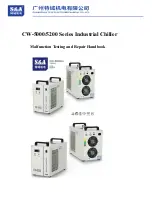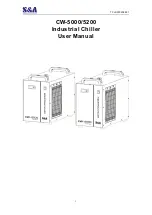
DC Inverter Chiller
44
3
Water System Design and Installation
3.1 Water Circuit Checks
Aqua Tempo Super II
units are equipped with a water inlet and outlet for connection to a water circuit. Aqua Tempo Super
II units should only be connected to closed water circuits. Connection to an open water circuit would lead to excessive
corrosion of the water piping. Only materials complying with all applicable legislation should be used.
Before continuing installation of the unit, check the following:
All chilled water pipelines should be thoroughly flushed, to be free of any impurity, before the unit is operated. Any
impurity should not be flushed to or into the heat exchanger.
Water must enter the heat exchanger through the inlet; otherwise the performance of the unit will decline.
The pump installed in the water pipeline system should be equipped with starter. The pump will directly press water
into the heat exchanger of the water system.
The pipes and their ports must be independently supported but should not be supported on the unit.
The pipes and their ports of the heat exchanger should be easy to disassemble for operation and cleaning, as well as
inspection of port pipes of the evaporator.
The evaporator should be provided with a filter with more than 40 meshes per inch at site. The filter should be
installed near to the inlet port as much as possible, and be under heat preservation.
The by-pass pipes and by-pass valves as shown in Figure 1-1.1: System schematic must be mounted for the
heat exchanger, to facilitate cleaning of the outside system of water passage before the unit is adjusted. During
maintenance, the water passage of the heat exchanger can be cut off without disturbing other heat exchangers.
The flexible ports should be adopted between the interface of the heat exchanger and on-site pipeline, to reduce
transfer of vibration to the building.
To facilitate maintenance, the inlet and outlet pipes should be provided with thermometer or manometer. The unit is
not equipped with pressure and temperature instruments, so they need to be purchased by the user.
All low positions of the water system should be provided with drainage ports, to drain water in the evaporator and the
system completely; and all high positions should be supplied with discharge valves, to facilitate expelling air from the
pipeline. The discharge valves and drainage ports should not be under heat preservation, to facilitate maintenance.
All possible water pipes in the system to be chilled should be under heat preservation, including inlet pipes and
flanges of the heat exchanger.
The outdoor chilled water pipelines should be wrapped with an auxiliary heating belt for heat preservation, and the
material of the auxiliary heat belt should be PE, EDPM, etc., with thickness of 20mm, to prevent the pipelines from
freezing and thus cracking under low temperature. The power supply of the heating belt should be equipped with an
independent fuse.
When the ambient temperature is lower than 2⁰C, and the unit will be not used for a long time, water inside the unit
should be drained. If the unit is not drained in winter, its power supply should not be cut off, and the fan coils in the
water system must be provided with three-way valves, to ensure smooth circulation of the water system when the
anti-freezing pump is started up in winter.
The common outlet pipelines of combined units should be provided with mixing water temperature sensor.
3.2 Water Quality Control
When industrial water is used as chilled water, little furring may occur; however, well water or river water, used as
chilled water, may cause much sediment, such as furring, sand, and so on. Therefore, well water or river water must
be filtered and softened in softening water equipment before flowing into chilled water system. If sand and clay settle
in the evaporator, circulation of chilled water may be blocked, and thus leading to freezing accidents; if hardness
of chilled water is too high, furring may occur easily, and the devices may be corroded. Therefore, the quality of
chilled water should be analyzed before being used, such as PH value, conductivity, concentration of chloride ion,
concentration of sulfide ion, and so on.
















































